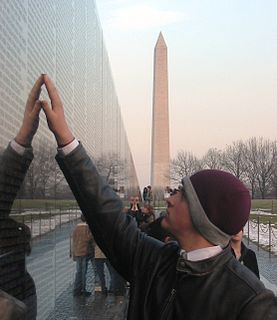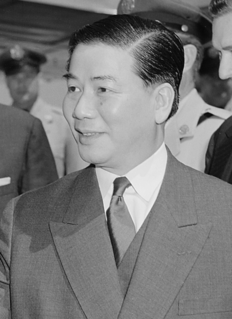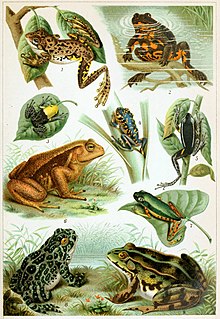
Agent Orange is a herbicide and defoliant chemical, one of the "tactical use" Rainbow Herbicides. It is widely known for its use by the U.S. military as part of its herbicidal warfare program, Operation Ranch Hand, during the Vietnam War from 1961 to 1971. It is a mixture of equal parts of two herbicides, 2,4,5-T and 2,4-D. In addition to its damaging environmental effects, traces of dioxin found in the mixture have caused major health problems for many individuals who were exposed.

The People's Army of Vietnam, also known as the Vietnamese People's Army (VPA), is the military force of the Socialist Republic of Vietnam. The PAVN is a part of the Vietnam People's Armed Forces and includes: Ground Force, Navy, Air Force, Border Defence Force, and Coast Guard. However, Vietnam does not have a separate Ground Force or Army branch. All ground troops, army corps, military districts and specialised arms belong to the Ministry of Defence, directly under the command of the Central Military Commission, the Minister of Defence, and the General Staff of the Vietnam People's Army. The military flag of the PAVN is the flag of the Socialist Republic of Vietnam, with the words Quyết thắng added in yellow at the top left.

The Vietnam War, also known as the Second Indochina War, and in Vietnam as the Resistance War Against America or simply the American War, was an undeclared war in Vietnam, Laos, and Cambodia from 1 November 1955 to the fall of Saigon on 30 April 1975. It was the second of the Indochina Wars and was officially fought between North Vietnam and South Vietnam. North Vietnam was supported by the Soviet Union, China, and other communist allies; South Vietnam was supported by the United States, South Korea, the Philippines, Australia, Thailand and other anti-communist allies. The war is considered a Cold War-era proxy war from some US perspectives. It lasted some 19 years with direct U.S. involvement ending in 1973 following the Paris Peace Accords, and included the Laotian Civil War and the Cambodian Civil War, resulting in all three countries becoming communist states in 1975.

The Vietnam Veterans Memorial is a 2-acre U.S. national memorial in Washington D.C. It honors service members of the U.S. armed forces who fought in the Vietnam War, service members who died in service in Vietnam/South East Asia, and those service members who were unaccounted for during the war.

French Indochina, officially known as the Indochinese Union after 1887 and the Indochinese Federation after 1947, was a grouping of French colonial territories in Southeast Asia.

Ngô Đình Diệm was a South Vietnamese politician. A former mandarin of the Nguyễn dynasty, he was named Prime Minister of the State of Vietnam by Head of State Bảo Đại in 1954. In October 1955, after winning a heavily rigged referendum, he deposed Bảo Đại and established the first Republic of Vietnam (RVN), with himself as president. He was a leader of the Catholic element and was opposed by Buddhists. In November 1963, after constant Buddhist protests and non-violent resistance, Diệm was assassinated during a CIA-backed coup d'état, along with his brother, Ngô Đình Nhu, by Nguyễn Văn Nhung, the aide of the leader of the Army of Republic of Vietnam (ARVN), General Dương Văn Minh. Diệm has been a controversial historical figure in historiography on the Vietnam War. Some historians portrayed him as a tool of the U.S. policymakers, some considered him an avatar of Vietnamese tradition. Nevertheless, some recent studies have portrayed Diệm from a more Vietnamese-centred perspective as a competent leader with his own vision on nation building and modernisation of South Vietnam.

Hanoi is Vietnam's capital and second largest city by population. The city mostly lies on the right bank of the Red River. Hanoi is 1,720 km (1,070 mi) north of Ho Chi Minh City and 105 km (65 mi) west of Haiphong.

South Vietnam, officially the Republic of Vietnam, was a country that existed from 1955 to 1975, the period when the southern portion of Vietnam was a member of the Western Bloc during part of the Cold War. It received international recognition in 1949 as the "State of Vietnam", which was a constitutional monarchy (1949–1955). This became the "Republic of Vietnam" in 1955. Its capital was Saigon. South Vietnam was bordered by North Vietnam to the north, Laos to the northwest, Cambodia to the southwest, Thailand across the Gulf of Thailand to the southwest, and the Philippines, Malaysia, Brunei, and Indonesia across the South China Sea to the east and southeast.

Ho Chi Minh City, also known by its former name of Saigon, is the most populous city in Vietnam with a population of 8.4 million as of 2017. Located in southeast Vietnam, the metropolis surrounds the Saigon River and covers about 2,061 square kilometres.

Hồ Chí Minh, born Nguyễn Sinh Cung, also known as Nguyễn Tất Thành,Nguyễn Ái Quốc, Bác Hồ or simply Bác, was a Vietnamese Communist revolutionary leader who was Chairman and First Secretary of the Workers' Party of Vietnam. He was also Prime Minister (1945–1955) and President (1945–1969) of the Democratic Republic of Vietnam. He was a key figure in the foundation of the Democratic Republic of Vietnam in 1945 at the Ba Dinh Square in Hanoi as well as the People's Army of Vietnam and the Viet Cong during the Vietnam War.

Việt Minh was a national independence coalition formed at Pác Bó by Hồ Chí Minh on May 19, 1941. The Việt Nam Độc Lập Đồng Minh Hội had previously formed in Nanjing, China, at some point between August 1935 and early 1936 when Vietnamese Nationalist or other Vietnamese nationalist parties formed an anti-imperialist united front. This organization soon lapsed into inactivity, only to be revived by the Indochinese Communist Party (ICP) and Hồ Chí Minh in 1941. The Việt Minh established itself as the only organized anti-French and anti-Japanese resistance group. The Việt Minh initially formed to seek independence for Vietnam from the French Empire. The United States supported France. When the Japanese occupation began, the Việt Minh opposed Japan with support from the United States and the Republic of China. After World War II, the Việt Minh opposed the re-occupation of Vietnam by France and later opposed South Vietnam and the United States in the Vietnam War. The political leader and founder of Việt Minh was Hồ Chí Minh. The military leadership was under the command of Võ Nguyên Giáp. Other founders were Lê Duẩn and Phạm Văn Đồng.

The Việt Cộng, also known as the National Liberation Front, was a mass political organization in South Vietnam and Cambodia with its own army – the People's Liberation Armed Forces of South Vietnam (PLAF) – that fought against the United States and South Vietnamese governments during the Vietnam War, eventually emerging on the winning side. It had both guerrilla and regular army units, as well as a network of cadres who organized peasants in the territory it controlled. Many soldiers were recruited in South Vietnam, but others were attached to the People's Army of Vietnam (PAVN), the regular North Vietnamese army. During the war, communists and anti-war activists insisted the Việt Cộng was an insurgency indigenous to the South, while the U.S. and South Vietnamese governments portrayed the group as a tool of Hanoi. Although the terminology distinguishes northerners from the southerners, communist forces were under a single command structure set up in 1958.
Vietnam Airlines is the flag carrier of Vietnam. The airline was founded in 1956 and later established as a state-owned enterprise in April 1989. Vietnam Airlines is headquartered in Long Biên District, Hanoi, with hubs at Noi Bai International Airport and Tan Son Nhat International Airport. The airline flies to 64 destinations in 17 countries, excluding codeshared services.

The Sino-Vietnamese War, also known as the Third Indochina War, was a brief border war fought between China and Vietnam in early 1979. China launched an offensive in response to Vietnam's invasion and occupation of Cambodia in 1978.

The Paris Peace Accords, officially titled the Agreement on Ending the War and Restoring Peace in Vietnam, was a peace treaty signed on January 27, 1973, to establish peace in Vietnam and end the Vietnam War. The treaty included the governments of the Democratic Republic of Vietnam, the Republic of Vietnam, and the United States, as well as the Provisional Revolutionary Government (PRG) that represented indigenous South Vietnamese revolutionaries. US ground forces up to that point had been sidelined with deteriorating morale and gradually withdrawn to coastal regions, not partaking in offensive operations or much direct combat for the preceding two-year period. The Paris Agreement Treaty would in effect remove all remaining US Forces, including air and naval forces in exchange for Hanoi's POWs. Direct U.S. military intervention was ended, and fighting between the three remaining powers temporarily stopped for less than a day. The agreement was not ratified by the United States Senate.

The Fall of Saigon, or the Liberation of Saigon, was the capture of Saigon, the capital of South Vietnam, by the People's Army of Vietnam (PAVN) and the Viet Cong on 30 April 1975. The event marked the end of the Vietnam War and the start of a transition period to the formal reunification of Vietnam into the Socialist Republic of Vietnam.

The Vietnam national football team is the national football team representing Vietnam in international football competitions and is managed by the Vietnam Football Federation (VFF).

The Cambodian–Vietnamese War, otherwise known in Vietnam as the Counter-offensive on the Southwestern border, was an armed conflict between the Socialist Republic of Vietnam and Democratic Kampuchea. The war began with isolated clashes along the land and maritime boundaries of Vietnam and Kampuchea between 1975 and 1978, occasionally involving division-sized military formations. On 25 December 1978, Vietnam launched a full-scale invasion of Kampuchea and subsequently occupied the country and removed the Communist Party of Kampuchea government from power.

North Vietnam, officially the Democratic Republic of Vietnam (DRV), was a country in Southeast Asia from 1945 to 1975.




















